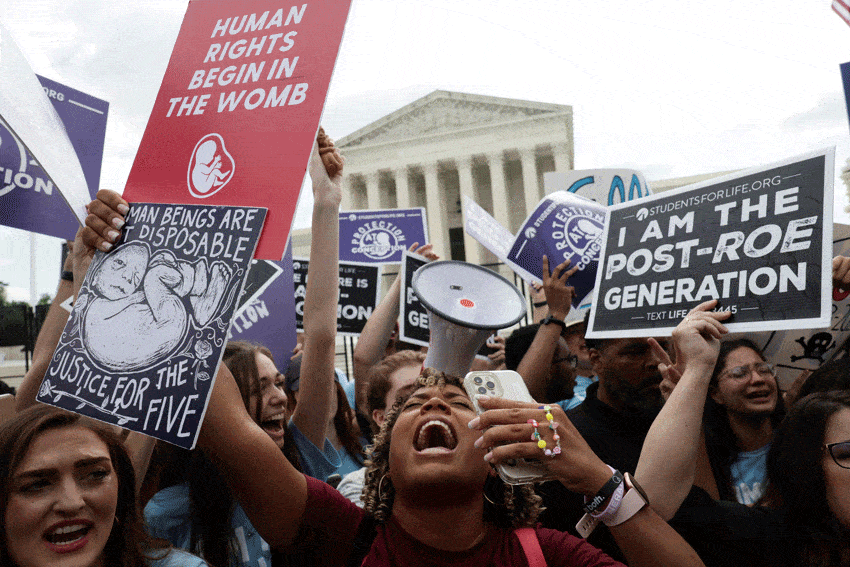
The reversal of Roe v. Wade is hugely significant and will have many ramifications. But the landmark decision doesn’t mean abortion is now illegal – far from it
Abortion is back in world news, because of a majority of the Supreme Court of the US (SCOTUS), in Dobbs v. Jackson Women’s Health Organisation, overturning its previous judgments in Roe v. Wade and Planned Parenthood v. Casey.
In these two earlier cases, the Supreme Court had created a Constitutional right for women not to be prevented from having access to abortion prior to foetal viability. To understand Dobbs, some background information on these two cases is required.
In Roe, a majority of the Court created in what they described as a “penumbra” of the Amendments in the US Constitution, its Bill of Rights, a constitutional right to bodily privacy.
They ruled that this gave a woman the constitutional right to control what happened to her body through accessing abortion and the State’s right to protect unborn human life was in conflict with it.
“The judgments in Roe and Casey applied to all states, however, because rulings on Constitutional rights take effect federally, and, as a result, many of these State laws restricting access to abortion were invalid.”
The Court in Roe then undertook a balancing approach to these conflicting rights claims, recognising that the state had an increasing interest in protecting the developing life of the foetus as the pregnancy progressed. In the subsequent case of Casey, the Court ruled that the State could legally restrict access to abortion only at viability of the fetus, usually set at 20 to 23 weeks gestation.
As in Australia, Criminal law is a state jurisdiction in the US and, before Roe, the state laws had criminalised abortion.
The judgments in Roe and Casey applied to all states, however, because rulings on Constitutional rights take effect federally, and, as a result, many of these State laws restricting access to abortion were invalid.
Mississippi’s law, which was challenged in Dobbs, limited abortion to the first 15 weeks of gestation and, therefore, contravened a woman’s constitutional right to access abortion as the law stood after Roe and Casey. Subsequent to Dobbs, such laws could now be valid.

Currently, I am often being asked, “What impact do you think the overturning of Roe might have on the discussion around abortion in Australia?” The short answer is it has no direct relevance, but, as with most major public bioethics issues, it could have repercussions.
It is difficult to predict what these will be, however, it is likely to stimulate the debate on the ethics of abortion and will highlight the deep divide between those who see abortion as not raising serious ethical problems, that is, as a ‘nothing event’, and those who see it as raising major ethical issues. These differences will be expressed in America in the likely huge discrepancies in the laws governing access to abortion across the different States.
The greatest discrepancies are likely to be the time after which abortion is prohibited, except on very narrow grounds. Georgia passed an abortion law on 7 May 2019, which prohibits abortions after a foetal heartbeat is detected, usually when a woman is six weeks pregnant. A similar law was passed in 2021 in Texas.
“In Dodds, a majority of SCOTUS justices overruled the constitutional right to privacy of one’s body, however, that does not mean that such a right does not exist in the law; it does, but now, at least in the United States, not as a constitutional right.”
It is noteworthy that just as the US has thrown out the trimester and viability approaches to permitting access to abortion, the Australian states have introduced and adopted a version of them in allowing abortion on demand up to 22 to 24 weeks gestation.
In Dodds, a majority of SCOTUS justices overruled the constitutional right to privacy of one’s body, however, that does not mean that such a right does not exist in the law; it does, but now, at least in the United States, not as a constitutional right. Such a right exists at Common Law and in certain legislation in Australia.
Other requirements governing abortion, already in place or likely to be introduced in Western democracies, include mandating pain management in fetuses being aborted, who could feel pain (13 weeks gestation or even as early as 9 weeks) and requiring women to see an ultrasound scan of the fetus before it may be aborted. Mandatory “cooling off” periods between seeking an abortion and having it are also likely.
Related Articles:
